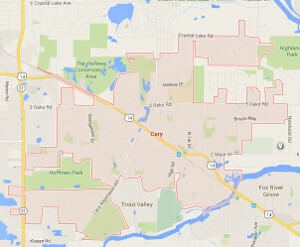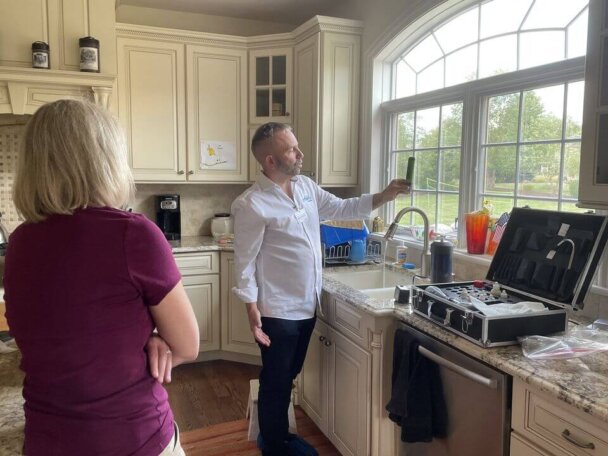Struggling with hard water in Cary, IL? Angel Water understands the specific water issues faced by residents here. Our high-quality water softening systems are designed to eliminate excess calcium and magnesium, providing soft, clean water for your home or business. With over 50 years of experience in the water treatment industry, we are dedicated to enhancing your water quality and ensuring your complete satisfaction.
Water Softeners in Cary, IL
How Do I Choose the Right Water Softener and Get Started?
The process begins with a water test to identify contaminants. Understanding these issues helps us create a solution. We then conduct a plumbing inspection to find the best installation spot. Finally, we determine the type and size of the necessary equipment.
Thinking, “Can’t you just tell me over the phone? You installed my neighbor’s system!” We understand – we’re consumers too. However, your neighbor’s water or plumbing might differ slightly. Our goal is to ensure you have perfect water for drinking and bathing. We provide unbiased third-party water testing and employ licensed plumbers as required by Illinois law, prioritizing your family’s health and well-being.
Why Choose Angel Water?
Expertise:
Over 50 years of experience in resolving water quality issues.
Advanced Technology:
Our water softeners use the latest technology for efficient operation.
Customer Satisfaction:
Free water analysis and customized solutions tailored to your needs.
Qualified Professionals:
IDPH Licensed Plumbers in Illinois ensure high-quality service and regulatory compliance.
Highly Rated:
Over 1,000 5-star ratings on Google demonstrate our commitment to excellent service.
Licensed Plumbing Company:
The only water softening company in Illinois that is also a licensed plumbing company.
Lifetime Warranty:
The only company offering a lifetime warranty on our ERR-3700 series filters.
A+ BBB Rating:
An A+ rating with the Better Business Bureau shows our commitment to quality service.
Benefits of Water Softening
Prevent Scale Buildup:
Soft water helps prevent scale buildup in pipes and appliances, extending their lifespan.
Better Cleaning:
Enjoy cleaner dishes, softer laundry, and easier cleaning.
Improved Skin and Hair:
Soft water is gentle on skin and hair, reducing dryness and irritation.

Water in Cary, Illinois
Cary, IL uses a combination ground water, which entails simply that the water is taken from beneath the ground, and source water, which comes from the likes of lakes, rivers, streams, ponds and reservoirs. Originating as precipitation from elements including rain and snow, ground water makes its way through the soil and into an aquifer. An aquifer is essentially a geologic formation that exists beneath the surface of the earth where collection of ground water is stored.
Website: https://www.caryillinois.com
Wikipedia: https://en.wikipedia.org/wiki/Cary,_Illinois
All of the water used in Cary is stored in one of nine existing wells that supply five treatment plants that work to reduce minerals like iron and manganese. Three more water softening plants are used to reduce the harness levels of water before the newly treated water is stored in 6 storage tanks throughout Cary and eventually traveling through over 75 miles of piping and into homes and businesses. It is reasonable to expect or anticipate that drinking water can be susceptible to containing at least small amounts of various contaminants including inorganic contaminants, microbial contaminants, herbicides and pesticides, radioactive contaminants and organic chemical contaminants. The presence of such contaminants does not necessarily pose a risk to the health of consumers. The EPA and FDA provide regulations that limit that acceptance of certain contaminants in water provided to the community and Cary proudly meets those standards.
Water contaminants may come from more than one source.
Local Water Polluters near Cary, IL
Village of Cary STP (305 Spring Street, Cary, Illinois 60013) – 11 Violations
- 2005 – 11 permit violations
About Cary, IL
Located in McHenry County, almost 40 miles northwest of the Chicago Loop, Cary, Illinois was first settled in 1856 by a local farmer named William Cary. Cary purchased 82 acres of land in the area for a mere $1.25 an acre in order to layout the town. The Illinois and Wisconsin Railroad was quick to accept the area for a station and soon after, Cary Station and a local post office was established in town.
Street improvements in the town became necessary as the population grew, so residents moved to incorporate the town into Cary, Illinois in 1893. The town was accommodating for farmers but also served as a place of residence for the people who worked on the railroad. The Illinois and Wisconsin Railroad became the Chicago and North Western Railway in 1859 and employed even more workers.
Away from the railroad and working in the pits, the surrounding grasslands provided the perfect atmosphere for dairy cattle and the 1880s showed the trains hauling away thousands of containers of milk from Cary every morning. By the early 1900s, Borden dairy opened a bottling plant operation in the town and shortly thereafter the Oatman Milk Company came into existence in the area.
The Fox River Valley, not far from Cary, proved to be the perfect setting for those wishing to vacation in a rustic, natural area. Hotels and resort spots popped up all over town and increased the area’s tourism business by a very large margin. From 1950 to 1980, Cary’s population grew from under 1,000 residents to 6,600 in just 30 short years. The population hit another high in 200, reaching over 15,000.
Today, the city of Cary spans over six square miles and boasts a population of over 18,000 residents. While the primary industries during the town’s birth were railroad and dairy farming, the current primary industry for Cary and the surrounding county is manufacturing, with residents bringing in an average salary of just over $35,000 a year. The landscape, however, is just as picturesque as ever
.

How do I know what system is right for my family?
Get Started With A Free Water Test!
Just fill out the form below and we will reach out to schedule the best time for your free water test!
Would You Like to Know More About Water Quality in Cary?
If you want to understand the quality of the water your family depends on everyday, contact us today. One of our representatives is standing by to help you schedule your free water test. We’ll send one of our local water expert to test the water at your tap and explain common problems and solutions for your specific water composition so that you can rest easy, knowing that your family is drinking the healthiest water possible.
